warning LOTUS ELISE 2005 Workshop Manual
[x] Cancel search | Manufacturer: LOTUS, Model Year: 2005, Model line: ELISE, Model: LOTUS ELISE 2005Pages: 205, PDF Size: 4.51 MB
Page 104 of 205
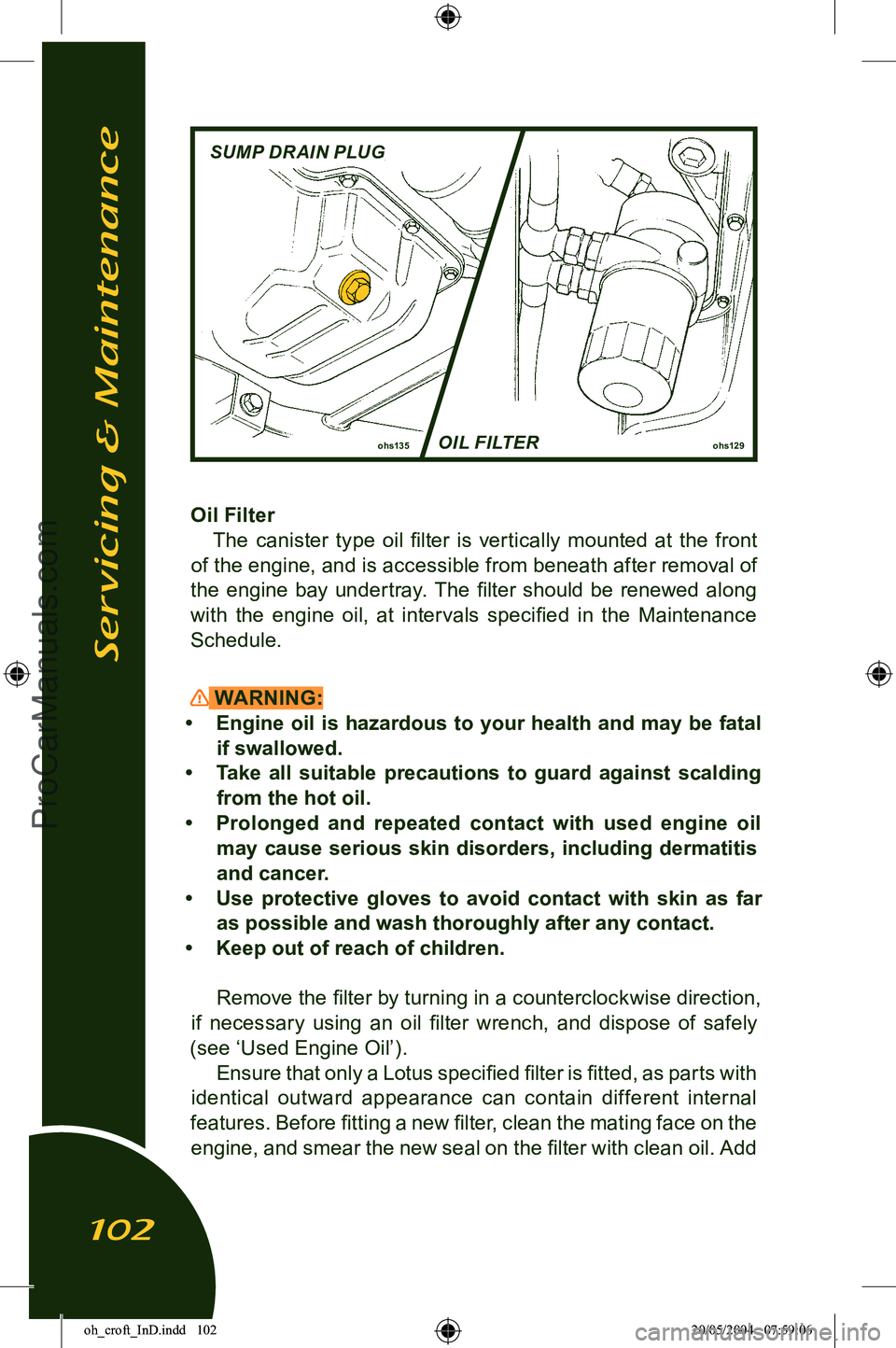
Oil FilterThe canister type oil filter is vertically mounted at the front
of the engine, and is accessible from beneath after removal of
the engine bay undertray. The filter should be renewed along
with the engine oil, at intervals specified in the Maintenance
Schedule.
WARNING:
• Engine oil is hazardous to your health and may be fatal
if swallowed.
• Take all suitable precautions to guard against scalding
from the hot oil.
• Prolonged and repeated contact with used engine oil may cause serious skin disorders, including dermatitis
and cancer.
• Use protective gloves to avoid contact with skin as far
as possible and wash thoroughly after any contact.
• Keep out of reach of children.
Remove the filter by turning in a counterclockwise direction,
if necessary using an oil filter wrench, and dispose of safely
(see ‘Used Engine Oil’). Ensure that only a Lotus specified filter is fitted, as parts with
identical outward appearance can contain different internal
features. Before fitting a new filter, clean the mating face on the engine, and smear the new seal on the filter with clean oil. Add
ohs129
ohs135
SUMP DRAIN PLUG
OIL FILTER
Servicing & Maintenance
102
oh_croft_InD.indd 10220/05/2004 07:59:06ProCarManuals.com
Page 106 of 205
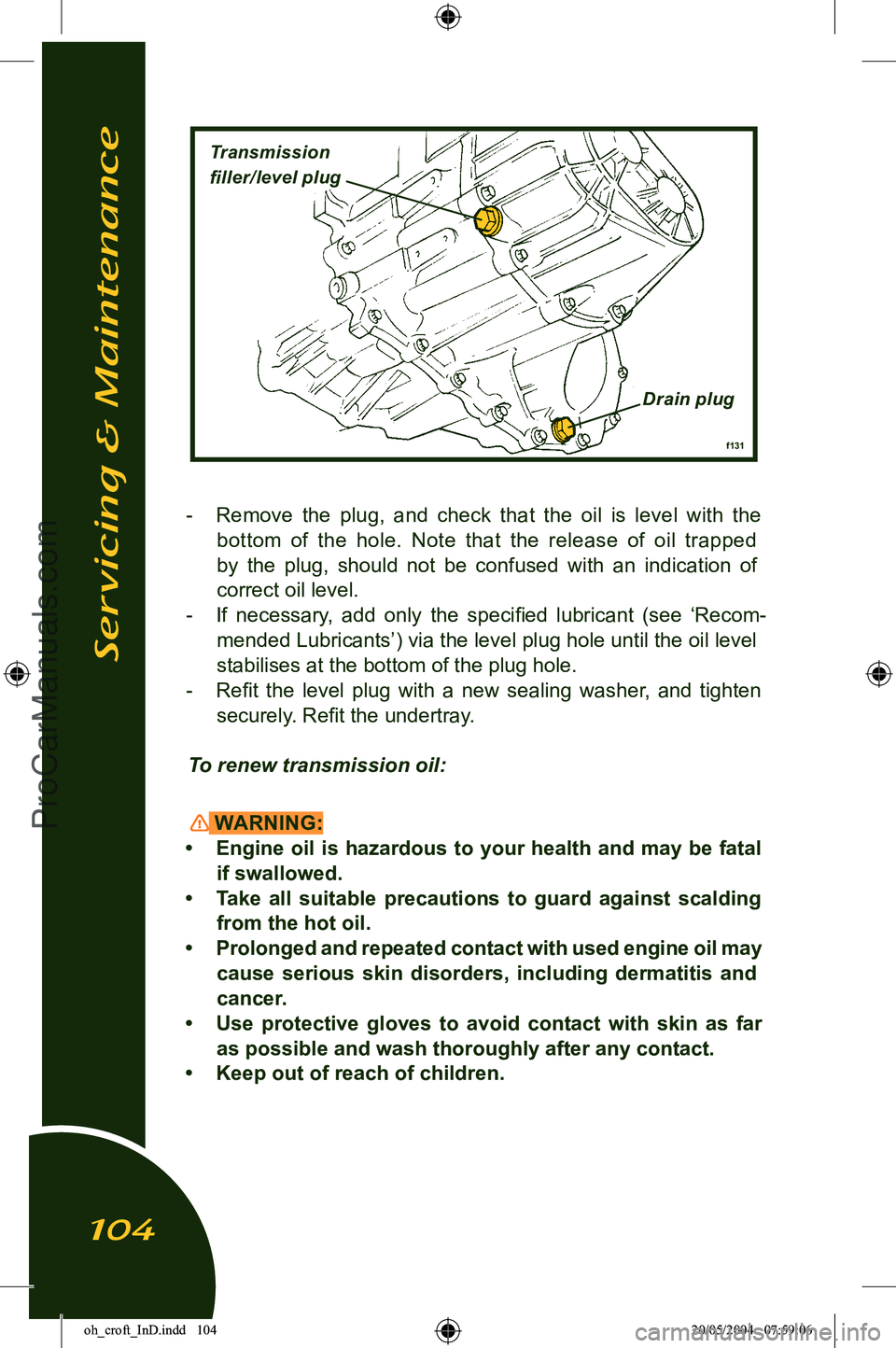
- Remove the plug, and check that the oil is level with the bottom of the hole. Note that the release of oil trapped
by the plug, should not be confused with an indication of
correct oil level.
- If necessary, add only the specified lubricant (see ‘Recom
-
mended Lubricants’) via the level plug hole until the oil level
stabilises at the bottom of the plug hole.
- Refit the level plug with a new sealing washer, and tighten securely. Refit the undertray.
To renew transmission oil:
WARNING:
• Engine oil is hazardous to your health and may be fatal
if swallowed.
• Take all suitable precautions to guard against scalding
from the hot oil.
• Prolonged and repeated contact with used engine oil may cause serious skin disorders, including dermatitis and
cancer.
• Use protective gloves to avoid contact with skin as far as possible and wash thoroughly after any contact.
• Keep out of reach of children.
Servicing & Maintenance
104
f131
Transmission
filler/level plug
Drain plug
oh_croft_InD.indd 10420/05/2004 07:59:06ProCarManuals.com
Page 108 of 205
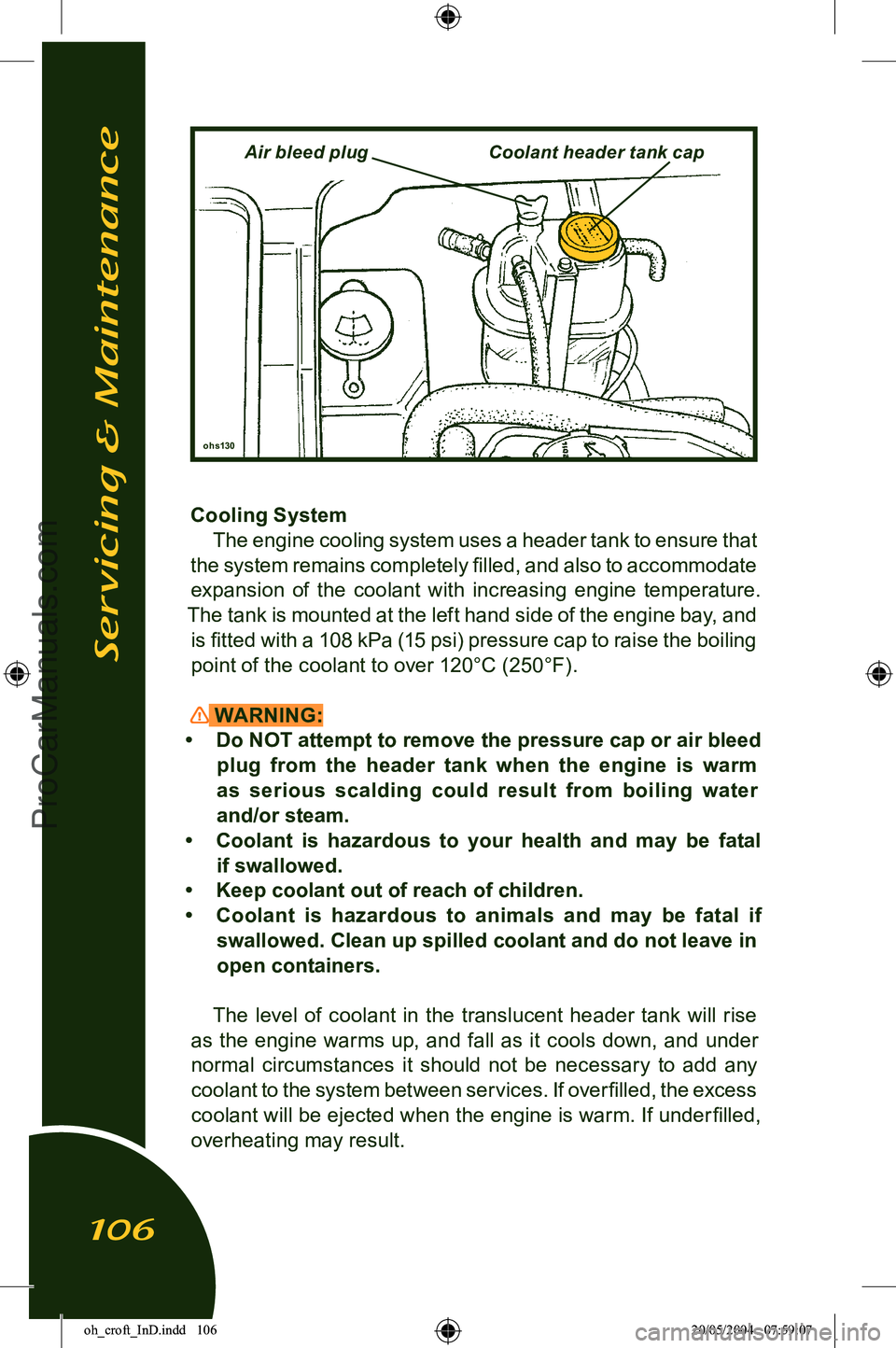
Cooling SystemThe engine cooling system uses a header tank to ensure that
the system remains completely filled, and also to accommodate
expansion of the coolant with increasing engine temperature.
The tank is mounted at the left hand side of the engine bay, and is fitted with a 108 kPa (15 psi) pressure cap to raise the boiling point of the coolant to over 120°C (250°F).
WARNING:
• Do NOT attempt to remove the pressure cap or air bleed plug from the header tank when the engine is warm
as serious scalding could result from boiling water
and/or steam.
• Coolant is hazardous to your health and may be fatal
if swallowed.
• Keep coolant out of reach of children.
• Coolant is hazardous to animals and may be fatal if
swallowed. Clean up spilled coolant and do not leave in
open containers.
The level of coolant in the translucent header tank will rise
as the engine warms up, and fall as it cools down, and under
normal circumstances it should not be necessary to add any
coolant to the system between services. If overfilled, the excess
coolant will be ejected when the engine is warm. If under filled, overheating may result.
Servicing & Maintenance
106
ohs130
Air bleed plugCoolant header tank cap
oh_croft_InD.indd 10620/05/2004 07:59:07ProCarManuals.com
Page 109 of 205

As a precaution, every week when the engine is completely
COLD, and without disturbing the filler cap, check that the level of coolant in the translucent tank is between the ‘FULL’
and ‘LOW’ marks moulded on the front of the tank. If topping
up is required, wait until the coolant has fully cooled before
turning the cap a quarter turn counterclockwise and allowing any remaining pressure to escape. Only then may the cap be
completely unscrewed. In order to maintain protection from freezing damage and
metal corrosion, use only an approved coolant mixture (see below) to top up the tank to the ‘FULL’ mark. Refit the cap, and
turn clockwise until the leg on the cap locates in the slot at the
front of the tank.
NOTICE: If the cap is removed when the engine is warm, the coolant may boil and a small coolant loss may occur. The com
-
pletely cold header tank level should be checked at the first subsequent opportunity.
Cooling Fans
: Two cooling fans are fitted below the radiator in
the air intake duct. The fans are energised at high coolant tem
-
peratures, or when the air conditioning (if fitted) is selected. The
fans will also run if certain types of engine fault are detected, and
may operate during a 20 minute period following ignition switch off to prevent ‘hot soak’ boiling. An electric coolant circulation pump may also be heard running during this period.
WARNING: Keep hands, tools and clothing away from the radiator
cooling fan area, as personal injury could result from the
fans starting up without warning.
At service intervals, the air duct and matrices of the engine
cooling radiator, a.c. condenser and oil coolers, should be
checked externally for clogging by insects, leaves or other debris,
and if necessary, a water jet used to clear the finning. Take care not to damage or distort the delicate finning of the radiator or
the cooling performance will be degraded.
Anti-Freeze/Corrosion Inhibitor It is most important that the correct coolant specification is
used in order to inhibit boiling and protect the engine and heat
Servicing & Maintenance
107
oh_croft_InD.indd 10720/05/2004 07:59:07ProCarManuals.com
Page 113 of 205
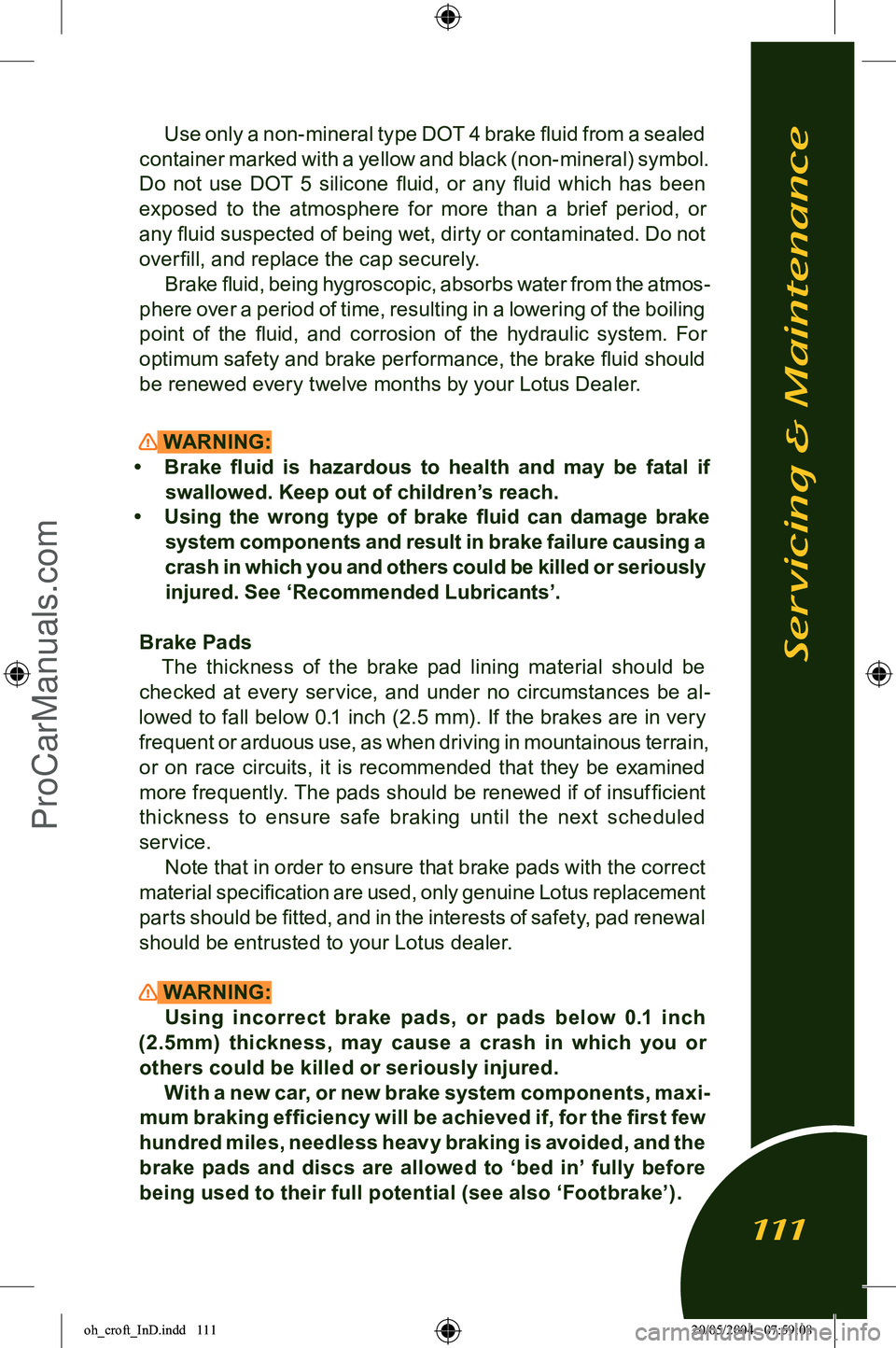
Use only a non-mineral type DOT 4 brake fluid from a sealed
container marked with a yellow and black (non-mineral) symbol.
Do not use DOT 5 silicone fluid, or any fluid which has been
exposed to the atmosphere for more than a brief period, or
any fluid suspected of being wet, dirty or contaminated. Do not over fill, and replace the cap securely. Brake fluid, being hygroscopic, absorbs water from the atmos
-
phere over a period of time, resulting in a lowering of the boiling
point of the fluid, and corrosion of the hydraulic system. For
optimum safety and brake performance, the brake fluid should be renewed every twelve months by your Lotus Dealer.
WARNING:
• Brake fluid is hazardous to health and may be fatal if swallowed. Keep out of children’s reach.
• Using the wrong type of brake fluid can damage brake system components and result in brake failure causing a
crash in which you and others could be killed or seriously
injured. See ‘Recommended Lubricants’.
Brake Pads The thickness of the brake pad lining material should be
checked at every service, and under no circumstances be al
-
lowed to fall below 0.1 inch (2.5 mm). If the brakes are in very frequent or arduous use, as when driving in mountainous terrain,
or on race circuits, it is recommended that they be examined
more frequently. The pads should be renewed if of insufficient
thickness to ensure safe braking until the next scheduled service.
Note that in order to ensure that brake pads with the correct
material specification are used, only genuine Lotus replacement parts should be fitted, and in the interests of safety, pad renewal
should be entrusted to your Lotus dealer.
WARNING: Using incorrect brake pads, or pads below 0.1 inch
(2.5mm) thickness, may cause a crash in which you or
others could be killed or seriously injured. With a new car, or new brake system components, maxi
-
mum braking efficiency will be achieved if, for the first few
hundred miles, needless heavy braking is avoided, and the
brake pads and discs are allowed to ‘bed in’ fully before
being used to their full potential (see also ‘Footbrake’).
Servicing & Maintenance
111
oh_croft_InD.indd 11120/05/2004 07:59:08ProCarManuals.com
Page 116 of 205

Auxiliary Drive BeltA single, multi-rib type auxiliary belt is used to transmit drive
from the crankshaft to the alternator, water pump, and (if fitted)
air conditioning compressor. The belt is automatically tensioned,
and requires no periodic maintenance other than a visual check of its condition. If the belt exhibits any evidence of physical dam
-
age, cracking, fraying, perishing, abrasion or contamination, it
should be renewed. In the case of contamination, the cause
must be identified and rectified, and each of the pulleys must be thoroughly degreased before the new belt is fitted. It is recommended that auxiliary belt replacement be en
-
trusted to your Lotus dealer.
Sparking Plugs The Elise uses a direct ignition system with an individual
high tension coil mounted atop each of the four spark plugs and protected by a plastic cover, screw fixed to the engine.
WARNING: The voltages produced with this ignition system can
cause serious and potentially fatal injur y. Never touch
any ignition components when the engine is running or being cranked.
The spark plugs should be renewed in accordance with the
Maintenance Schedule, with the gaps set to 0.043 in. (1.1 mm).
This operation should be entrusted to your Lotus dealer.
Servicing & Maintenance
114
oh_croft_InD.indd 11420/05/2004 07:59:09ProCarManuals.com
Page 117 of 205
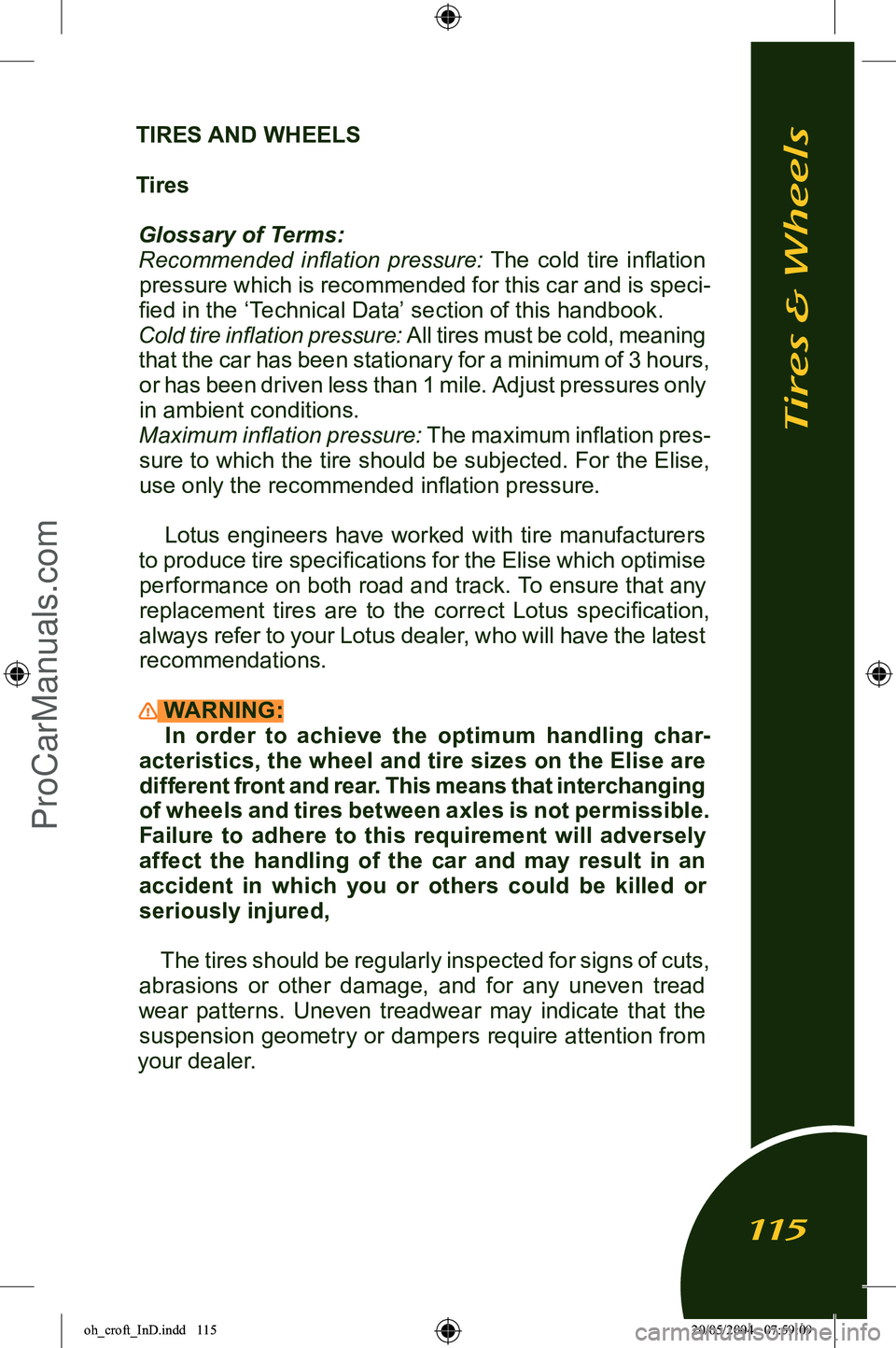
TIRES AND WHEELS
TiresGlossary of Terms:Recommended inflation pressure: The cold tire inflation pressure which is recommended for this car and is speci
-
fied in the ‘Technical Data’ section of this handbook.
Cold tire inflation pressure: All tires must be cold, meaning
that the car has been stationary for a minimum of 3 hours, or has been driven less than 1 mile. Adjust pressures only
in ambient conditions.
Maximum inflation pressure: The maximum inflation pres
-
sure to which the tire should be subjected. For the Elise,
use only the recommended inflation pressure.
Lotus engineers have worked with tire manufacturers
to produce tire specifications for the Elise which optimise performance on both road and track. To ensure that any
replacement tires are to the correct Lotus specification,
always refer to your Lotus dealer, who will have the latest recommendations.
WARNING: In order to achieve the optimum handling char
-
acteristics, the wheel and tire sizes on the Elise are different front and rear. This means that interchanging
of wheels and tires between axles is not permissible.
Failure to adhere to this requirement will adversely affect the handling of the car and may result in an
accident in which you or others could be killed or seriously injured,
The tires should be regularly inspected for signs of cuts,
abrasions or other damage, and for any uneven tread
wear patterns. Uneven treadwear may indicate that the suspension geometry or dampers require attention from
your dealer.
Tires & Wheels
115
oh_croft_InD.indd 11520/05/2004 07:59:09ProCarManuals.com
Page 118 of 205
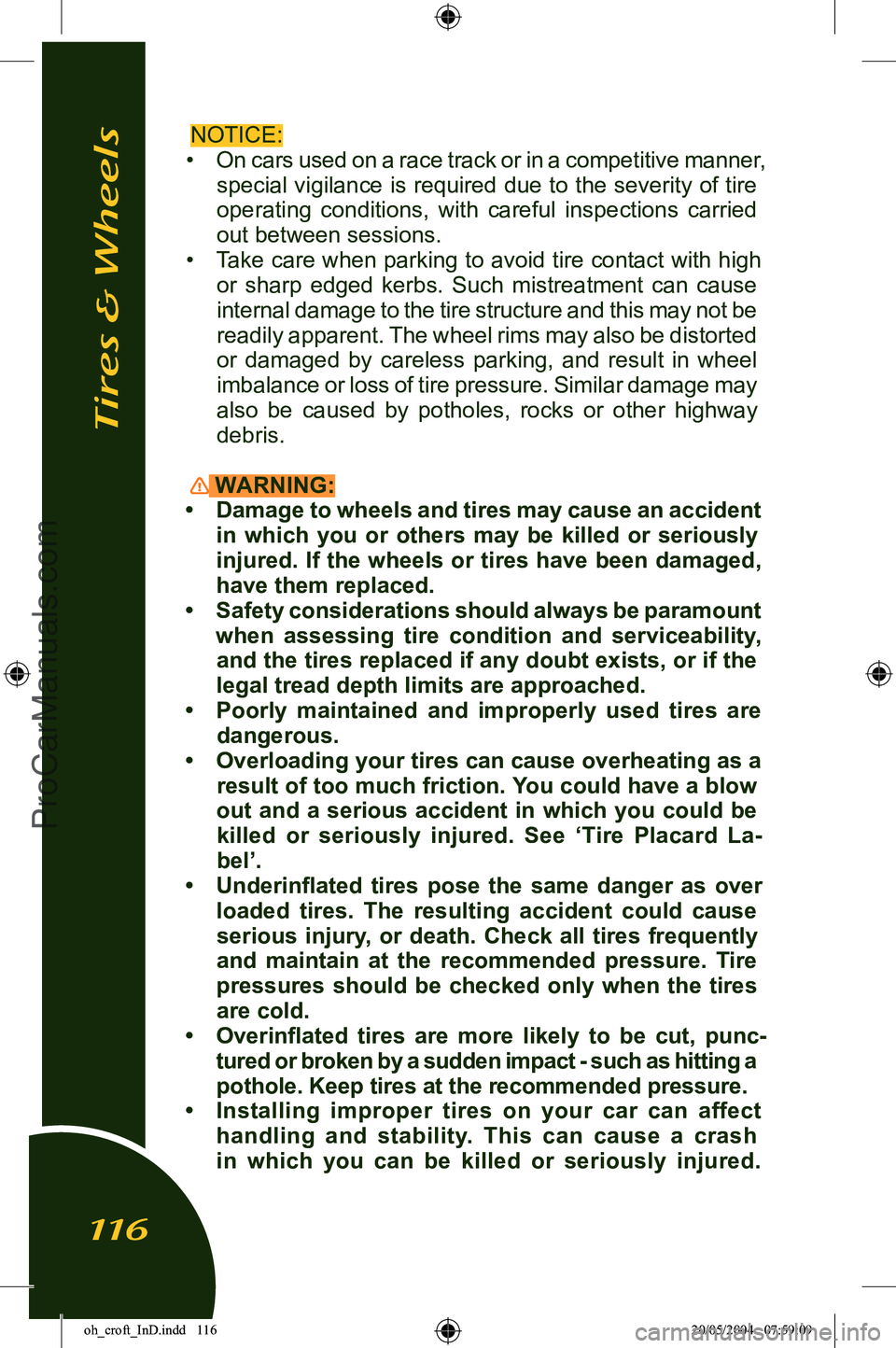
NOTICE:
• On cars used on a race track or in a competitive manner,
special vigilance is required due to the severity of tire operating conditions, with careful inspections carried
out between sessions.
• Take care when parking to avoid tire contact with high
or sharp edged kerbs. Such mistreatment can cause
internal damage to the tire structure and this may not be readily apparent. The wheel rims may also be distorted or damaged by careless parking, and result in wheel
imbalance or loss of tire pressure. Similar damage may also be caused by potholes, rocks or other highway
debris.
WARNING:
• Damage to wheels and tires may cause an accident in which you or others may be killed or seriously
injured. If the wheels or tires have been damaged,
have them replaced.
• Safety considerations should always be paramount when assessing tire condition and serviceability, and the tires replaced if any doubt exists, or if the
legal tread depth limits are approached.
• Poorly maintained and improperly used tires are dangerous.
• Overloading your tires can cause overheating as a result of too much friction. You could have a blow
out and a serious accident in which you could be killed or seriously injured. See ‘Tire Placard La
-
bel’.
• Underinflated tires pose the same danger as over loaded tires. The resulting accident could cause serious injury, or death. Check all tires frequently
and maintain at the recommended pressure. Tire
pressures should be checked only when the tires
are cold.
• Overinflated tires are more likely to be cut, punc- tured or broken by a sudden impact - such as hitting a pothole. Keep tires at the recommended pressure.
• Installing improper tires on your car can affect handling and stability. This can cause a crash
in which you can be killed or seriously injured.
Tires & Wheels
116
oh_croft_InD.indd 11620/05/2004 07:59:09ProCarManuals.com
Page 120 of 205

Use a good quality proprietary tire pressure gauge and always replace the tire valve dust cap to prevent the
ingress of dirt and moisture into the valve, which could cause leakage. Many fuel filling stations provide tire inflation facilities,
which specific usage instructions should be carefully fol
-
lowed. For tire pressure information, refer to ‘Technical
Data’ or the Certification Label on the driver’s door jamb
(see page 121).
Replacement Tires When replacing tires, refer to the ‘Technical Data’ sec
-
tion in this handbook, or consult your dealer to check the current Lotus specification and recommendations. Do not
use tires which differ from these specifications.
WARNING: Note that some tread patterns are directional, so
that the tire must be fitted onto the wheel with regard
to which side of the car the wheel is to be used. In
these cases, a direction of rotation arrow is included in the tire sidewall markings.
When balancing the wheel and tire assemblies, the
wheels should be located by the centre spigot hole - NOT by the wheel bolt holes. In order to maintain the correct
ohs115b
Direction of rotation arrow
Tires & Wheels
118
oh_croft_InD.indd 11820/05/2004 07:59:10ProCarManuals.com
Page 121 of 205
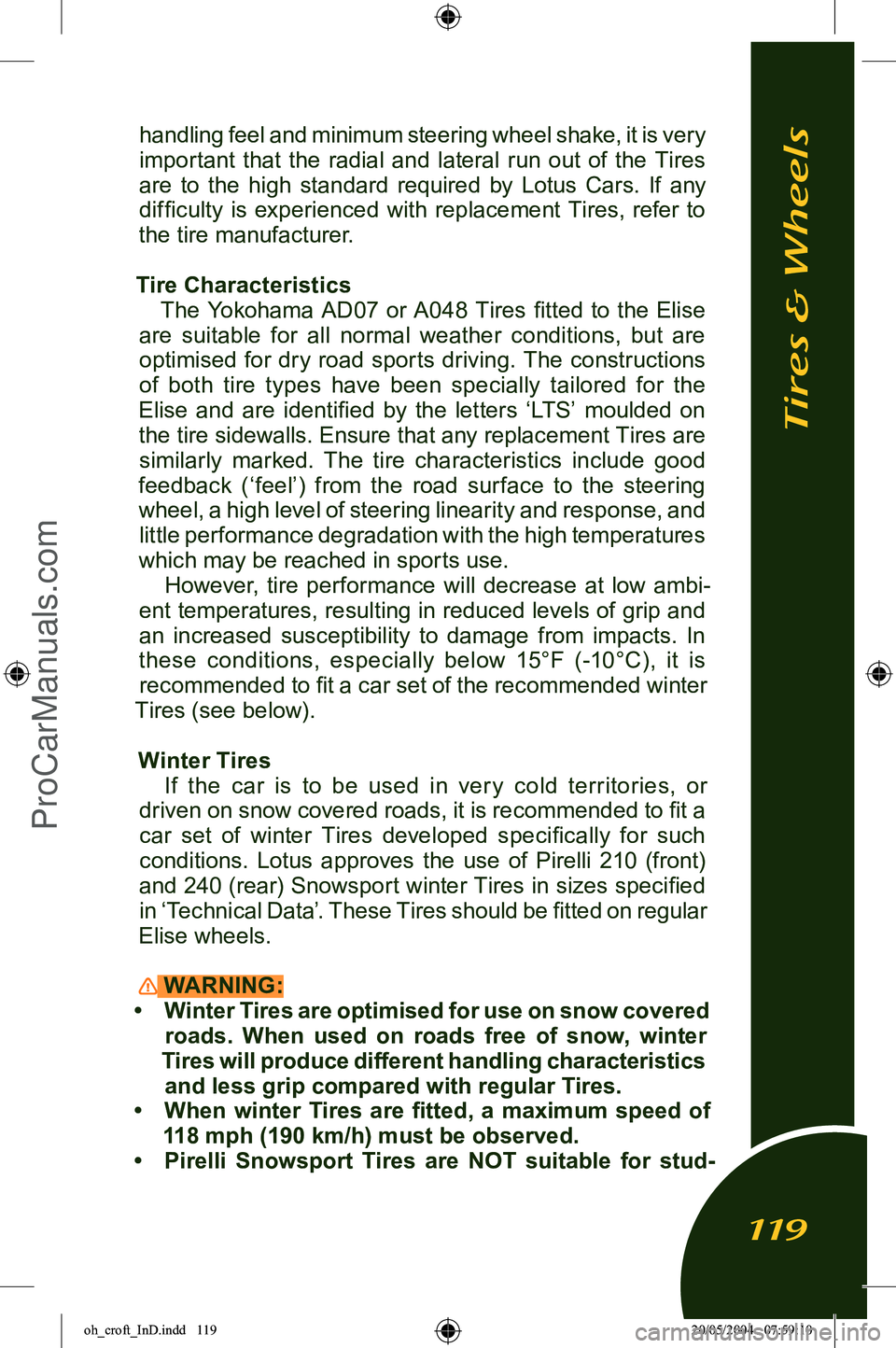
handling feel and minimum steering wheel shake, it is very
important that the radial and lateral run out of the Tires are to the high standard required by Lotus Cars. If any difficulty is experienced with replacement Tires, refer to
the tire manufacturer.
Tire Characteristics The Yokohama AD07 or A048 Tires fitted to the Elise
are suitable for all normal weather conditions, but are optimised for dry road sports driving. The constructions
of both tire types have been specially tailored for the
Elise and are identified by the letters ‘LTS’ moulded on the tire sidewalls. Ensure that any replacement Tires are similarly marked. The tire characteristics include good
feedback (‘feel’) from the road surface to the steering
wheel, a high level of steering linearity and response, and little performance degradation with the high temperatures
which may be reached in sports use. However, tire performance will decrease at low ambi
-
ent temperatures, resulting in reduced levels of grip and
an increased susceptibility to damage from impacts. In
these conditions, especially below 15°F (-10°C), it is recommended to fit a car set of the recommended winter
Tires (see below).
Winter Tires If the car is to be used in ver y cold territories, or
driven on snow covered roads, it is recommended to fit a
car set of winter Tires developed specifically for such
conditions. Lotus approves the use of Pirelli 210 (front)
and 240 (rear) Snowsport winter Tires in sizes specified
in ‘Technical Data’. These Tires should be fitted on regular
Elise wheels.
WARNING:
• Winter Tires are optimised for use on snow covered roads. When used on roads free of snow, winter
Tires will produce different handling characteristics and less grip compared with regular Tires.
• When winter Tires are fitted, a maximum speed of 118 mph (190 km/h) must be observed.
• Pirelli Snowsport Tires are NOT suitable for stud
-
Tires & Wheels
119
oh_croft_InD.indd 11920/05/2004 07:59:10ProCarManuals.com